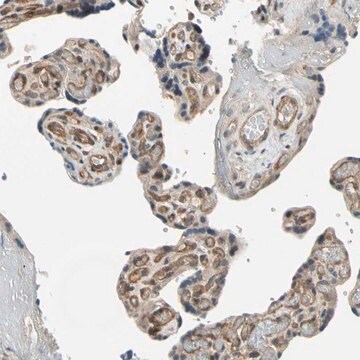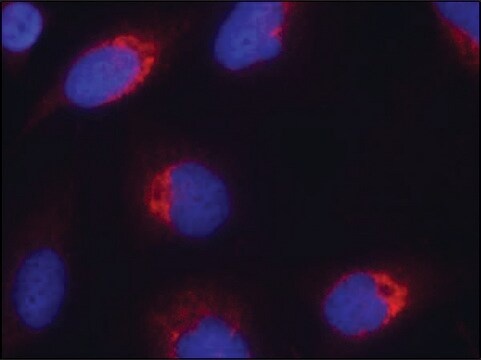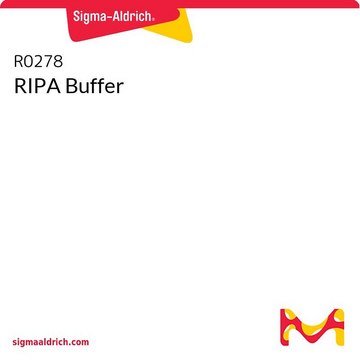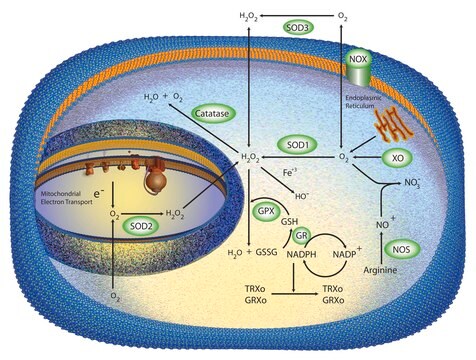Alle Fotos(1)
Wichtige Dokumente
E7525
Anti-Ephrin-B2 antibody produced in goat
affinity isolated antibody
Anmeldenzur Ansicht organisationsspezifischer und vertraglich vereinbarter Preise
Alle Fotos(1)
About This Item
Konjugat:
unconjugated
application:
FACS
ICC
WB
ICC
WB
Klon:
polyclonal
Speziesreaktivität:
mouse
citations:
2
Methode(n):
flow cytometry: 0.25 μg using 106 cells
immunocytochemistry: 5-15 μg/mL
western blot: 1 μg/mL
immunocytochemistry: 5-15 μg/mL
western blot: 1 μg/mL
Empfohlene Produkte
Biologische Quelle
goat
Qualitätsniveau
Konjugat
unconjugated
Antikörperform
affinity isolated antibody
Antikörper-Produkttyp
primary antibodies
Klon
polyclonal
Speziesreaktivität
mouse
Methode(n)
flow cytometry: 0.25 μg using 106 cells
immunocytochemistry: 5-15 μg/mL
western blot: 1 μg/mL
UniProt-Hinterlegungsnummer
Lagertemp.
−20°C
Posttranslationale Modifikation Target
unmodified
Angaben zum Gen
mouse ... Efnb2(13642)
Allgemeine Beschreibung
By immunoblotting and ELISA, the antibody shows ~50% cross-reactivity with recombinant human ephrin-B5 and 15% cross-reactivity with mouse ephrin-B1.
Immunogen
recombinant mouse ephrin-B2, expressed in NSO cells.
Biochem./physiol. Wirkung
Ephrin B2 binds to EPH receptor B, a protein-tyrosine kinase family that belongs to the ephrin receptor subfamily. EphB receptors and EphrinB ligands have a regulatory effect on endothelial cell function, angiogenesis, migration, cell growth and survival.
Physikalische Form
Lyophilized from a 0.2 μm filtered solution in phosphate buffered saline, pH 7.4 with 5% trehalose.
Haftungsausschluss
Unless otherwise stated in our catalog or other company documentation accompanying the product(s), our products are intended for research use only and are not to be used for any other purpose, which includes but is not limited to, unauthorized commercial uses, in vitro diagnostic uses, ex vivo or in vivo therapeutic uses or any type of consumption or application to humans or animals.
Sie haben nicht das passende Produkt gefunden?
Probieren Sie unser Produkt-Auswahlhilfe. aus.
Lagerklassenschlüssel
12 - Non Combustible Liquids
WGK
WGK 1
Flammpunkt (°F)
Not applicable
Flammpunkt (°C)
Not applicable
Hier finden Sie alle aktuellen Versionen:
Besitzen Sie dieses Produkt bereits?
In der Dokumentenbibliothek finden Sie die Dokumentation zu den Produkten, die Sie kürzlich erworben haben.
T Inada et al.
Blood, 89(8), 2757-2765 (1997-04-15)
HTK is a receptor tyrosine kinase of the Eph family. To characterize the involvement of HTK in hematopoiesis, we generated monoclonal antibodies against HTK and investigated its expression on human bone marrow cells. About 5% of the bone marrow cells
H U Wang et al.
Cell, 93(5), 741-753 (1998-06-18)
The vertebrate circulatory system is composed of arteries and veins. The functional and pathological differences between these vessels have been assumed to reflect physiological differences such as oxygenation and blood pressure. Here we show that ephrin-B2, an Eph family transmembrane
B D Bennett et al.
Proceedings of the National Academy of Sciences of the United States of America, 92(6), 1866-1870 (1995-03-14)
Htk is a receptor protein-tyrosine kinase that is related to the EPH subfamily of tyrosine kinases. The receptor has a wide tissue distribution including expression in several myeloid hematopoietic cell lines. Using an Htk-Fc fusion protein, a protein ligand for
T Vogt et al.
Clinical cancer research : an official journal of the American Association for Cancer Research, 4(3), 791-797 (1998-05-14)
The Lerks, ligands of eph-related receptor tyrosine kinases, are a rapidly expanding family of genes thought to play an important role in the development and oncogenesis of various tissues. However, very little experimental evidence supports this hypothesis. Using RNA fingerprinting
Essential roles of EphB receptors and EphrinB ligands in endothelial cell function and angiogenesis.
Ombretta Salvucci et al.
Advances in cancer research, 114, 21-57 (2012-05-17)
Eph receptor tyrosine kinases and their Ephrin ligands represent an important signaling system with widespread roles in cell physiology and disease. Receptors and ligands in this family are anchored to the cell surface; thus Eph/Ephrin interactions mainly occur at sites
Unser Team von Wissenschaftlern verfügt über Erfahrung in allen Forschungsbereichen einschließlich Life Science, Materialwissenschaften, chemischer Synthese, Chromatographie, Analytik und vielen mehr..
Setzen Sie sich mit dem technischen Dienst in Verbindung.








